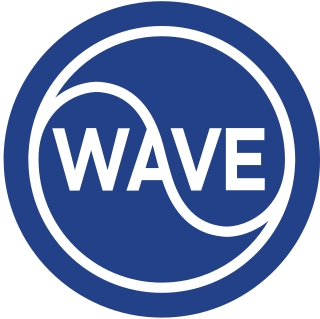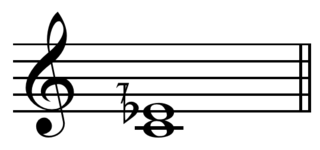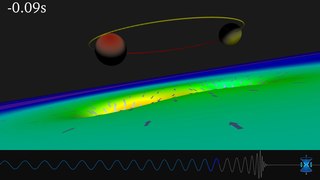In music theory, the term mode or modus is used in a number of distinct senses, depending on context.

Microwave is a form of electromagnetic radiation with wavelengths shorter than other radio waves but longer than infrared waves. Its wavelength ranges from about one meter to one millimeter, corresponding to frequencies between 300 MHz and 300 GHz, broadly construed. A more common definition in radio-frequency engineering is the range between 1 and 100 GHz, or between 1 and 3000 GHz . The prefix micro- in microwave is not meant to suggest a wavelength in the micrometer range; rather, it indicates that microwaves are small, compared to the radio waves used in prior radio technology.

Quantum mechanics is a fundamental theory that describes the behavior of nature at and below the scale of atoms. It is the foundation of all quantum physics, which includes quantum chemistry, quantum field theory, quantum technology, and quantum information science.

A tsunami is a series of waves in a water body caused by the displacement of a large volume of water, generally in an ocean or a large lake. Earthquakes, volcanic eruptions and underwater explosions above or below water all have the potential to generate a tsunami. Unlike normal ocean waves, which are generated by wind, or tides, which are in turn generated by the gravitational pull of the Moon and the Sun, a tsunami is generated by the displacement of water from a large event.

In physics and mathematics, wavelength or spatial period of a wave or periodic function is the distance over which the wave's shape repeats. In other words, it is the distance between consecutive corresponding points of the same phase on the wave, such as two adjacent crests, troughs, or zero crossings. Wavelength is a characteristic of both traveling waves and standing waves, as well as other spatial wave patterns. The inverse of the wavelength is called the spatial frequency. Wavelength is commonly designated by the Greek letter lambda (λ). The term "wavelength" is also sometimes applied to modulated waves, and to the sinusoidal envelopes of modulated waves or waves formed by interference of several sinusoids.

Radio waves are a type of electromagnetic radiation with the lowest frequencies and the longest wavelengths in the electromagnetic spectrum, typically with frequencies below 300 gigahertz (GHz) and wavelengths greater than 1 millimeter, about the diameter of a grain of rice. Like all electromagnetic waves, radio waves in a vacuum travel at the speed of light, and in the Earth's atmosphere at a slightly lower speed. Radio waves are generated by charged particles undergoing acceleration, such as time-varying electric currents. Naturally occurring radio waves are emitted by lightning and astronomical objects, and are part of the blackbody radiation emitted by all warm objects.

A power inverter, inverter, or invertor is a power electronic device or circuitry that changes direct current (DC) to alternating current (AC). The resulting AC frequency obtained depends on the particular device employed. Inverters do the opposite of rectifiers which were originally large electromechanical devices converting AC to DC.

The WaveBird Wireless Controller is a radio frequency-based wireless controller manufactured by Nintendo for use with the GameCube home video game console. Its name is a reference to Dolphin, the GameCube's codename during development. The WaveBird was available for purchase separately as well as in bundles with either Metroid Prime or Mario Party 4, which were exclusive to Kmart in the US.

WAVE is a television station in Louisville, Kentucky, United States, affiliated with NBC and owned by Gray Television. The station's studios are located on South Floyd Street in downtown Louisville, and its transmitter is located in Floyds Knobs, Indiana.

DWAV, on-air as Adventist World Radio 89.1, is a radio station owned by Blockbuster Broadcasting System and operated under an airtime lease agreement by the Adventist Media. The station's studio is located at the North Philippines Union Conference Compound, #210 San Juan St., Pasay, while its transmitter is located at Palos Verdes Executive Village, Brgy. Sta. Cruz, Sumulong Highway, Antipolo.

In music, the septimal minor third, also called the subminor third or septimal subminor third, is the musical interval exactly or approximately equal to a 7/6 ratio of frequencies. In terms of cents, it is 267 cents, a quartertone of size 36/35 flatter than a just minor third of 6/5. In 24-tone equal temperament five quarter tones approximate the septimal minor third at 250 cents. A septimal minor third is almost exactly two-ninths of an octave, and thus all divisions of the octave into multiples of nine have an almost perfect match to this interval. The septimal major sixth, 12/7, is the inverse of this interval.

Gravitational waves are transient displacements in a gravitational field – generated by the motion or acceleration of gravitating masses – that radiate outward from their source at the speed of light. They were first proposed by Oliver Heaviside in 1893 and then later by Henri Poincaré in 1905 as the gravitational equivalent of electromagnetic waves. In 1916, Albert Einstein demonstrated that gravitational waves result from his general theory of relativity as ripples in spacetime.

The Game Wave Family Entertainment System, commonly abbreviated as Game Wave, is a hybrid DVD player and home video game console manufactured by ZAPiT Games. It is part of the seventh generation of video game consoles.
For the wave phenomenon, see sneaker wave.

Hurricane Guillermo was the ninth-most intense Pacific hurricane on record, attaining peak winds of 160 mph (260 km/h) and a barometric pressure of 919 hPa (27.14 inHg). Forming out of a tropical wave on July 30, 1997, roughly 345 mi (555 km) south of Salina Cruz, Mexico, Guillermo tracked in a steady west-northwestward direction while intensifying. The system reached hurricane status by August 1 before undergoing rapid intensification the following day. At the end of this phase, the storm attained its peak intensity as a powerful Category 5 hurricane. The storm began to weaken during the afternoon of August 5 and was downgraded to a tropical storm on August 8. Once entering the Central Pacific Hurricane Center's area of responsibility, Guillermo briefly weakened to a tropical depression before re-attaining tropical storm status. On August 15, the storm reached an unusually high latitude of 41.8°N before transitioning into an extratropical cyclone. The remnants persisted for more than a week as they tracked towards the northeast and later south and east before being absorbed by a larger extratropical system off the coast of California on August 24.

"Love Is the Seventh Wave" is a hit single from Sting's 1985 solo debut album The Dream of the Blue Turtles. It was released as the album's second single in the UK, and the third single in the US.

Radio is the technology of communicating using radio waves. Radio waves are electromagnetic waves of frequency between 3 hertz (Hz) and 300 gigahertz (GHz). They are generated by an electronic device called a transmitter connected to an antenna which radiates oscillating electrical energy, often characterized as a wave. They can be received by other antennas connected to a radio receiver, this is the fundamental principle of radio communication. In addition to communication, radio is used for radar, radio navigation, remote control, remote sensing, and other applications.

West Seventh is a neighborhood and city district in Saint Paul, Minnesota. It comprises three smaller neighborhoods: from west to east, the West End, Uppertown, and Irvine Park. The neighborhood lies at the base of Summit Hill and along the Mississippi River's western bluffs, spanning the entire length of West 7th Street. It is also known as Old Fort Road and the Fort Road area. The street follows a historic Native American and fur trader path along the river from downtown Saint Paul to Fort Snelling.

The Search for Everything: Wave Two is an extended play (EP) by American singer-songwriter John Mayer. Released on February 24, 2017 by Columbia and Sony Music, the EP contains four tracks from Mayer's seventh studio album, The Search for Everything, and is a follow-up to its predecessor EP, The Search for Everything: Wave One. It includes the lead single "Still Feel Like Your Man".
In the German Wehrmacht before and during World War II, infantry divisions were raised as part of a designated Aufstellungswelle or Welle (wave), sometimes translated as "draft". The Aufstellungswelle system was adopted by the Wehrmacht in late 1938. Peacetime units were the first wave, and 34 other waves followed until the 35th wave in April 1945. Several types of divisions were organized by Aufstellungswelle, including infantry, security, shadow and Volksgrenadier divisions.

















